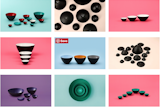The Story of an Extraordinary Bowl
A MATERIAL SCIENTIST BECOMES A DESIGNER
Driven by his fascination with materials and the Danish design traditions, the material researcher and scientist Herbert Krenchel, became a designer almost by chance. His obsession with finding the perfectly thin edge - resembling a millimeter thin steel plate - lead him to design the iconic Krenit bowl in 1953. "With a background as civil engineer and material scientist, I have always had a fascination for materials. It was just that fascination - almost an infatuation - with materials that led me to design the Krenit bowl," he says.
Following the example of the USA, where it has been highly popular to eat green salad, the leafy greens also became a popular meal in Denmark in the 1950s. This created a demand for new ways of preparing and presenting food.
"I wanted no unnecessary ornaments or decorations, just a sharp and balanced interplay of form and material."
Herbert Krenchel became so inspired by the demand for a new salad dish, that he went home to work on a new design for such a bowl himself. Soon, the first Krenit bowl was born, which he named the C-bowl (ø 12,5 cm).
Herbert Krenchel became so inspired by the demand for a new salad dish, that he went home to work on a new design for such a bowl himself. Soon, the first Krenit bowl was born, which he named the C-bowl (ø 12,5 cm).
REVOLUTIONIZING PRODUCTION TECHNIQUES
Herbert Krenchel’s desire was to make a beautiful piece of craftsmanship that would be used in the kitchen as well as on the dining table; a design piece that would exude high quality and exclusivity."I am excited about shapes and structures. The surface on a design object is important because it makes people want to reach out for it. I also believe that there has to be a balance between function and aesthetics. A good design must therefore contain more than one aspect to make the perfect overall impression," Herbert Krenchel stated.
As a material scientist, Herbert Krenchel knew from his work that enamel was a durable and strong material that also had a smooth and shiny surface. Herbert Krenchel felt very inspired by enamel material, as it seemed to fulfil the requirements he envisioned for the bowl.
At the time, enamel was was not a very expensive or exclusive material and typically used for chamber pots, soap dishes and water jugs. The procedure Herbert Krenchel had in mind, was entirely unheard of.
Yet, he found a way to make it work! With a new technique that Herbert Krenchel developed himself, the bowl got a colorful and pleasantly polished layer of enamel that evenly spread on the inside, while the outside had a black matte finish.
KRENIT BECOMES INTERNATIONAL DESIGN ICON
After Krenit was launched in 1953 in Denmark, it did not take long until the bowl became renowned internationally, won design awards, and was displayed in international design exhibitions.
In 1964, the production of the Krenit bowl stopped. By that time around 1 million bowls had been produced since 1953. From then on, Krenit was only available through auctions and flea markets, and was traded all over the world.
It was in 2007, when Herbert Krenchel and his family approached Normann Copenhagen and wished for them to resume the production of the Krenit bowl. Jan Andersen and Poul Madsen, the founders of Normann Copenhagen, remember:
"We were not a second in doubt about resuming production. The Krenit series has the simple and straightforward expression that we stand for at Normann Copenhagen."
This year, the Krenit bowl was launched in new metallic shades of gold and silver, inspired by an original design made by Herbert Krenchel in the 1950s with real silver. Jan and Poul loved the shine and exclusive appearance of the metallic version, and added a new version of the Krenit bowl in the glistening gold and silver - just in time for Christmas.
DANISH DESIGN
It was in the 1950s and 1960s that Danish design classics were made and that Danish design became to be a term known worldwide, representing well-thought-out designs, where the form of an object weighs equally as its function.
Today, we are experiencing a huge interest in Danish design again. There are a great number of talented modern designers, with many of today’s values based on those we saw in the Danish Golden Age of Design in the 50s and 60s - but with a new, contemporary angle.
Jan Andersen, one of the Normann Copenhagen founders, explains: "As Danes we grew up with design. Design tradition lies deep within us, and we have become accustomed to form and function being the key criteria. We therefore do not think about that the salad bowl of our childhood is not just a salad bowl, but also a large and international design icon."
Poul Madsen adds, "at Normann Copenhagen we love Danish design, and we are proudly based on the Danish design tradition and heritage. Its minimalism and simplicity is something we have taken with us - in everything we design. It was with the utmost respect for Herbert Krenchel’s original design that Normann Copenhagen launched this iconic design piece."
Since its launch in 2008, the Krenit series has become one of Normann Copenhagen’s most popular design items. With its characteristic sharp edge, the bowl creates a delicate balance between material and shape, giving it its modern expression. This extraordinary bowl fits into any modern home today just as perfectly as it did when it was designed in 1953.
Available in six sizes that each come in nine different colors, the possible uses for the Krenit bowl are as myriad as the number of its versions. The bowl makes a great gift for yourself, or for friends and family!
Published
Get the Dwell Newsletter
Be the first to see our latest home tours, design news, and more.





